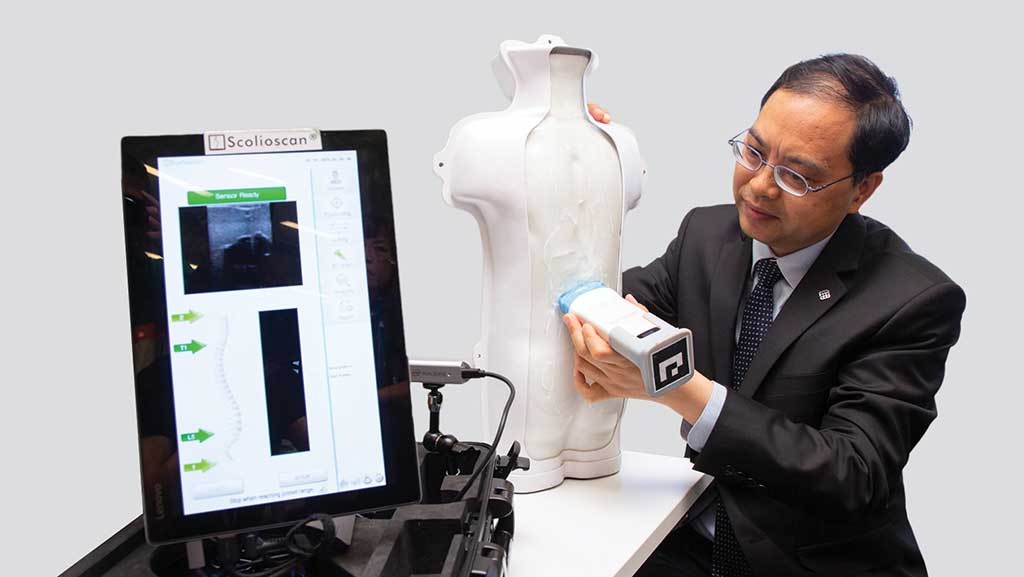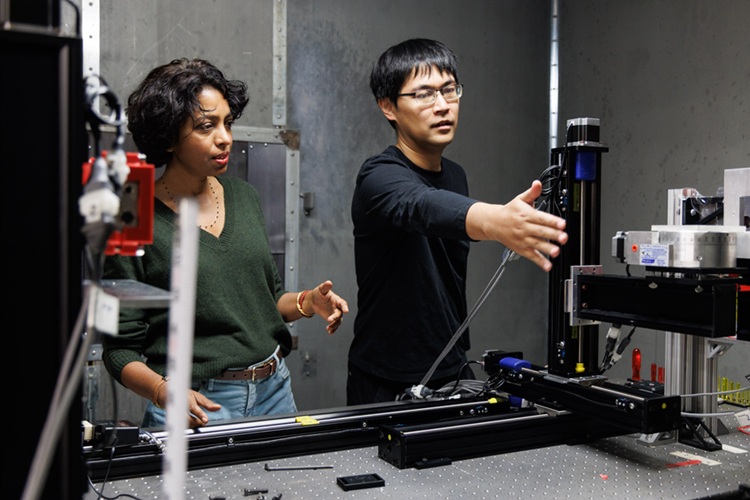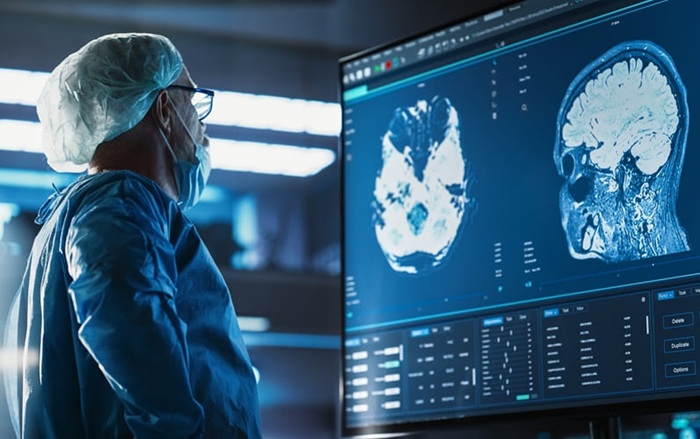Ultrasound Reduces Unnecessary Scoliosis Screening X-Rays
|
By MedImaging International staff writers Posted on 15 Jul 2021 |

Image: The Scolioscan device used for ultrasound screening in Hong Kong (Photo courtesy of PolyU)
Using dedicated ultrasound to screen schoolchildren for scoliosis prior to specialist referral can help reduce radiation exposure, according to a new study.
Researchers at the Chinese University of Hong Kong (CUHK), Nanjing University (NJU; China), and Hong Kong Polytechnic University (PolyU) conducted a prospective diagnostic study to evaluate the accuracy of ultrasound in determining the threshold of specialist scoliosis referral that requires X-ray for children screened positive with the scoliometer and Moiré topography. The study included 442 schoolchildren with a mean Cobb angle of 14.0 ± 6.6°.
The results showed that ultrasound could predict the correct referral status (as confirmed by X-ray), with a sensitivity of 92.3% and a specificity of 51.6%, with positive and negative predictive values of 29.0% and 96.9%, respectively. The finding support using ultrasound to determine scoliosis referral status, with a possible 50% or more reduction of unnecessary radiation. The study was published on June 28, 2021, in Ultrasound in Medicine and Biology.
“Ultrasound could be considered for incorporation into the scoliosis screening program for maintaining radiation exposure as low as reasonably achievable, especially for immature participants,” concluded lead author Henry Pang, MD, of CUHK, and colleagues. “Ultrasound use in scoliosis could be extended by establishing a model for predicting the Cobb angle based on the angle of spinous processes. However, more studies would be needed to confirm this.”
Scoliosis is a condition in which a person's spine, on an X-ray viewed from the rear, may look more like an "S" or a "C" than a straight line. It is the most common spinal deformity in children, most often diagnosed between ages 10 to 18. In Hong Kong, scoliosis screening programs follow a protocol referring children screened positive with a scoliometer and Moiré topography for confirmatory radiography. But despite being highly sensitive (88%), the screening program was found to have a false-positive rate of over 50%, which could lead to unnecessary X-ray radiation.
Related Links:
Chinese University of Hong Kong
Nanjing University
Hong Kong Polytechnic University
Researchers at the Chinese University of Hong Kong (CUHK), Nanjing University (NJU; China), and Hong Kong Polytechnic University (PolyU) conducted a prospective diagnostic study to evaluate the accuracy of ultrasound in determining the threshold of specialist scoliosis referral that requires X-ray for children screened positive with the scoliometer and Moiré topography. The study included 442 schoolchildren with a mean Cobb angle of 14.0 ± 6.6°.
The results showed that ultrasound could predict the correct referral status (as confirmed by X-ray), with a sensitivity of 92.3% and a specificity of 51.6%, with positive and negative predictive values of 29.0% and 96.9%, respectively. The finding support using ultrasound to determine scoliosis referral status, with a possible 50% or more reduction of unnecessary radiation. The study was published on June 28, 2021, in Ultrasound in Medicine and Biology.
“Ultrasound could be considered for incorporation into the scoliosis screening program for maintaining radiation exposure as low as reasonably achievable, especially for immature participants,” concluded lead author Henry Pang, MD, of CUHK, and colleagues. “Ultrasound use in scoliosis could be extended by establishing a model for predicting the Cobb angle based on the angle of spinous processes. However, more studies would be needed to confirm this.”
Scoliosis is a condition in which a person's spine, on an X-ray viewed from the rear, may look more like an "S" or a "C" than a straight line. It is the most common spinal deformity in children, most often diagnosed between ages 10 to 18. In Hong Kong, scoliosis screening programs follow a protocol referring children screened positive with a scoliometer and Moiré topography for confirmatory radiography. But despite being highly sensitive (88%), the screening program was found to have a false-positive rate of over 50%, which could lead to unnecessary X-ray radiation.
Related Links:
Chinese University of Hong Kong
Nanjing University
Hong Kong Polytechnic University
Latest Ultrasound News
- Wearable Ultrasound Imaging System to Enable Real-Time Disease Monitoring
- Ultrasound Technique Visualizes Deep Blood Vessels in 3D Without Contrast Agents
- Ultrasound Probe Images Entire Organ in 4D

- Disposable Ultrasound Patch Performs Better Than Existing Devices
- Non-Invasive Ultrasound-Based Tool Accurately Detects Infant Meningitis
- Breakthrough Deep Learning Model Enhances Handheld 3D Medical Imaging
- Pain-Free Breast Imaging System Performs One Minute Cancer Scan
- Wireless Chronic Pain Management Device to Reduce Need for Painkillers and Surgery
- New Medical Ultrasound Imaging Technique Enables ICU Bedside Monitoring
- New Incision-Free Technique Halts Growth of Debilitating Brain Lesions
- AI-Powered Lung Ultrasound Outperforms Human Experts in Tuberculosis Diagnosis
- AI Identifies Heart Valve Disease from Common Imaging Test
- Novel Imaging Method Enables Early Diagnosis and Treatment Monitoring of Type 2 Diabetes
- Ultrasound-Based Microscopy Technique to Help Diagnose Small Vessel Diseases
- Smart Ultrasound-Activated Immune Cells Destroy Cancer Cells for Extended Periods
- Tiny Magnetic Robot Takes 3D Scans from Deep Within Body
Channels
Radiography
view channel
AI Detects Early Signs of Aging from Chest X-Rays
Chronological age does not always reflect how fast the body is truly aging, and current biological age tests often rely on DNA-based markers that may miss early organ-level decline. Detecting subtle, age-related... Read more
X-Ray Breakthrough Captures Three Image-Contrast Types in Single Shot
Detecting early-stage cancer or subtle changes deep inside tissues has long challenged conventional X-ray systems, which rely only on how structures absorb radiation. This limitation keeps many microstructural... Read moreMRI
view channel
Novel Imaging Approach to Improve Treatment for Spinal Cord Injuries
Vascular dysfunction in the spinal cord contributes to multiple neurological conditions, including traumatic injuries and degenerative cervical myelopathy, where reduced blood flow can lead to progressive... Read more
AI-Assisted Model Enhances MRI Heart Scans
A cardiac MRI can reveal critical information about the heart’s function and any abnormalities, but traditional scans take 30 to 90 minutes and often suffer from poor image quality due to patient movement.... Read more
AI Model Outperforms Doctors at Identifying Patients Most At-Risk of Cardiac Arrest
Hypertrophic cardiomyopathy is one of the most common inherited heart conditions and a leading cause of sudden cardiac death in young individuals and athletes. While many patients live normal lives, some... Read moreNuclear Medicine
view channel
PET Imaging of Inflammation Predicts Recovery and Guides Therapy After Heart Attack
Acute myocardial infarction can trigger lasting heart damage, yet clinicians still lack reliable tools to identify which patients will regain function and which may develop heart failure.... Read more
Radiotheranostic Approach Detects, Kills and Reprograms Aggressive Cancers
Aggressive cancers such as osteosarcoma and glioblastoma often resist standard therapies, thrive in hostile tumor environments, and recur despite surgery, radiation, or chemotherapy. These tumors also... Read more
New Imaging Solution Improves Survival for Patients with Recurring Prostate Cancer
Detecting recurrent prostate cancer remains one of the most difficult challenges in oncology, as standard imaging methods such as bone scans and CT scans often fail to accurately locate small or early-stage tumors.... Read moreGeneral/Advanced Imaging
view channel
AI-Based Tool Accelerates Detection of Kidney Cancer
Diagnosing kidney cancer depends on computed tomography scans, often using contrast agents to reveal abnormalities in kidney structure. Tumors are not always searched for deliberately, as many scans are... Read more
New Algorithm Dramatically Speeds Up Stroke Detection Scans
When patients arrive at emergency rooms with stroke symptoms, clinicians must rapidly determine whether the cause is a blood clot or a brain bleed, as treatment decisions depend on this distinction.... Read moreImaging IT
view channel
New Google Cloud Medical Imaging Suite Makes Imaging Healthcare Data More Accessible
Medical imaging is a critical tool used to diagnose patients, and there are billions of medical images scanned globally each year. Imaging data accounts for about 90% of all healthcare data1 and, until... Read more
Global AI in Medical Diagnostics Market to Be Driven by Demand for Image Recognition in Radiology
The global artificial intelligence (AI) in medical diagnostics market is expanding with early disease detection being one of its key applications and image recognition becoming a compelling consumer proposition... Read moreIndustry News
view channel
GE HealthCare and NVIDIA Collaboration to Reimagine Diagnostic Imaging
GE HealthCare (Chicago, IL, USA) has entered into a collaboration with NVIDIA (Santa Clara, CA, USA), expanding the existing relationship between the two companies to focus on pioneering innovation in... Read more
Patient-Specific 3D-Printed Phantoms Transform CT Imaging
New research has highlighted how anatomically precise, patient-specific 3D-printed phantoms are proving to be scalable, cost-effective, and efficient tools in the development of new CT scan algorithms... Read more
Siemens and Sectra Collaborate on Enhancing Radiology Workflows
Siemens Healthineers (Forchheim, Germany) and Sectra (Linköping, Sweden) have entered into a collaboration aimed at enhancing radiologists' diagnostic capabilities and, in turn, improving patient care... Read more



















